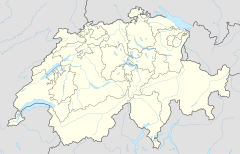Zürich Airport railway station
Zurich Airport railway station (German: Bahnhof Zürich Flughafen) is a railway station serving Zurich Airport in Switzerland. The station is located underneath the Airport Centre, the main ground-side passenger terminal of the airport, which is in the canton of Zurich and the municipality of Kloten.[3][4]
History
When Zurich Airport first opened in 1948, the nearest railway was the single-track line from Oerlikon to Effretikon, forming a loop off the original main line of the Zurich to Winterthur line. This line passed through Kloten Balsberg and Kloten stations, which are respectively 1.5 kilometres (0.93 mi) and 2.1 kilometres (1.3 mi) from the airport terminal. In 1980 and in order to improve access to the airport, a new main line was constructed between Oerlikon and Effretikon. The new line passed under the airport terminal, and the airport railway station was opened. Originally the station was planned to be served only by intercity trains, but it is now served by a mixture of long distance and suburban trains.[5][6]
The previous line from Oerlikon through Kloten Balsberg and Kloten to Bassersdorf was retained, and is used by suburban trains that do not call at the airport and freight trains. The section from Bassersdorf to Effretikon was abandoned, and trains off the Kloten line now join the new line for this section of their journey. Other suburban trains use the original main line through Dietlikon.[5][7]
Layout and facilities
Train
The station is situated on the airport railway line between Oerlikon and Effretikon, which forms one variant of the Zurich to Winterthur main line. The station, which is entirely underground, has two island platforms serving four tracks, each with a length of 400 metres (1,300 ft). The platforms are linked to the Airport Centre, which contains the station ticket office, by escalators and lifts. The Airport Centre also contains several floors of retail and catering facilities, as well as access, via check-in and security, to the Airside Center and gate lounges.[4][8]
Summary of track (Gleis) usage:[9]
- Track 1: EuroCity,
 ,
,  ,
,  towards Winterthur; S2 towards Zürich HB.
towards Winterthur; S2 towards Zürich HB. - Track 2:
 ,
,  , S24 towards Winterthur.
, S24 towards Winterthur. - Track 3:
 ,
,  ,
,  ,
,  ,
,  , S16 towards Zürich HB.
, S16 towards Zürich HB. - Track 4:
 ,
,  , S24 towards Zürich HB.
, S24 towards Zürich HB.
Bus and tram
The airport terminal complex also includes a bus station, served by regional bus lines (PostAuto, Glattalbus), and a station on the Stadtbahn Glattal light rail system, served by Zurich tram lines 10 and 12. These can be accessed from the station via the Airport Centre.[4][10][11]
Operation
The station is served by approximately 300 trains per day, formed of a mixture of EuroCity (EC) InterCity (IC) and InterRegio (IR) trains, serving cities throughout Switzerland, as well as Zurich S-Bahn trains on lines S2, S16 and S24. Most trains also serve Zürich Hauptbahnhof, the city's main railway station, with, for most of the day, some 13 trains per hour (tph) taking between 9 and 13 minutes for the journey.[7]
The airport station is also linked to Konstanz station, just over the border in Germany, by an hourly Swiss InterRegio train. Several daily EuroCity trains call at the airport station en route from Zürich Hauptbahnhof to Bregenz, in Austria, and various German cities as far as Munich.
Services
As of the December 2023 timetable change, the following services stop at Zürich Airport:[9]
- EuroCity: service every two hours between Zürich HB and München Hbf.
- InterCity:
 /
/  : half-hourly service between Geneva Airport or Lausanne and St. Gallen; hourly service to Rorschach.
: half-hourly service between Geneva Airport or Lausanne and St. Gallen; hourly service to Rorschach. /
/  : hourly service between Spiez and Romanshorn; service every two hours from Spiez to Brig and Interlaken Ost.
: hourly service between Spiez and Romanshorn; service every two hours from Spiez to Brig and Interlaken Ost.
- InterRegio:
- Zurich S-Bahn:
- S2: half-hourly service to Ziegelbrücke, via Zürich HB.
- S16: half-hourly service to Herrliberg-Feldmeilen, via Zürich HB.
- S24: half-hourly service between Zug (via Zürich HB) and Winterthur; trains continue from Winterthur to Thayngen or Weinfelden.
Gallery
- Wall art in the station
- Double-deck S-Bahn (left) and InterRegio (right) trains in the station
- A train to Basel in the station
- The Airport Centre at-grade level, one level above the station's offices and ticketing machines, and two levels above the tracks
See also
References
- ^ "Tarifzonen" (PDF) (in German). Zürcher Verkehrsverbund. 13 December 2020. Retrieved 26 December 2020.
- ^ "Passagierfrequenz (2023)". Lausanne, Switzerland: SBB CFF FFS. 2023. Retrieved 4 August 2024 – via data.sbb.ch – SBB DATA PORTAL.
- ^ map.geo.admin.ch (Map). Swiss Confederation. Retrieved 23 April 2012.
- ^ a b c Eisenbahnatlas Schweiz. Cologne: Schweers + Wall. 2012. pp. 64–65. ISBN 978-3-89494-130-7.
- ^ a b map.geo.admin.ch with Siegfried Map First edition overlaid (Map). Swiss Confederation. Retrieved 26 February 2016.
- ^ "Airport History". Flughafen Zürich AG. Retrieved 30 July 2015.
- ^ a b "S-Bahn trains, buses and boats" (PDF). ZVV. 9 December 2018. Retrieved 21 September 2019.
- ^ "Stop: platform length (body)". data.sbb.ch. Retrieved 17 December 2022.
- ^ a b "Abfahrt/Departure: Bahnhof/Station Zürich Flughafen" (PDF). Swiss Federal Railways (in German). 11 December 2022. Retrieved 29 January 2023.
- ^ "Regional Network (50)" (PDF). ZVV. Retrieved 23 April 2012.
- ^ "Zürich Flughafen | Zurich Airport" (PDF). ZVV. 15 December 2019. Retrieved 3 July 2020.
External links
 Media related to Zürich Flughafen railway station at Wikimedia Commons
Media related to Zürich Flughafen railway station at Wikimedia Commons- Zürich Airport railway station – SBB










